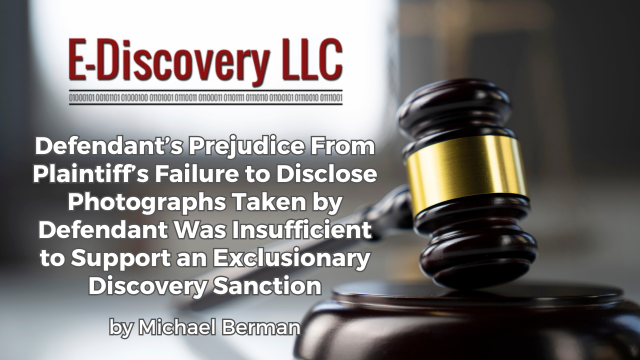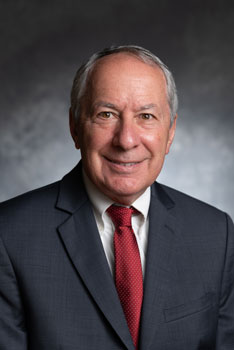
[EDRM Editor’s Note: The opinions and positions are those of Michael Berman.]
In Matter of City of Hagerstown, __ Md. App. __,2025 WL 1540660 (May 30, 2025), the defendant City claimed unfair surprise when plaintiff sought to introduce at trial photographs that the City had taken, but which plaintiff had not disclosed in discovery. The Court affirmed the holding that the asserted prejudice from the failure to produce was insufficient to support exclusion of the evidence.
Simply stated, after plaintiff complained of health issues due to mold in the workplace, defendant took photos of the scene where the claim arose. Plaintiff also had them. In discovery, defendant asked for all photos, and any documents on which plaintiff intended to rely on at trial. Plaintiff did not produce the photos in discovery; however, plaintiff sought to rely on them at trial. Defendant sought exclusion as a discovery sanction. It asserted prejudice because it could not call the person who took the photos as a trial witness. Defendant’s objection was overruled. The Appellate Court of Maryland affirmed.
“This appeal concerns a decision by the Workers’ Compensation Commission awarding temporary total disability benefits. The employee claimed that he developed respiratory problems after he encountered mold while performing building repairs.” Id. at *1. The Commission awarded temporary total disability benefits and the employer petitioned for judicial review. The jury found in the employee’s favor and this appeal followed.
This appeal concerns a decision by the Workers’ Compensation Commission awarding temporary total disability benefits. The employee claimed that he developed respiratory problems after he encountered mold while performing building repairs.
Matter of City of Hagerstown, __ Md. App. __,2025 WL 1540660, at *1 (May 30, 2025).
The employee, Mr. Johnson, had been assigned to provide renovation work in the “map room.” He became ill. “Around the same time that Mr. Johnson stopped working, a contractor inspected the Barn building at the request of the City. The contractor took photographs of areas of suspected mold in the basement level. Sampling tests confirmed the presence of mold, including mold on the walls of the map room.” [emphasis added].
This blog focuses on the discovery issue related to the photographs. The opinion is more than 40 pages and addresses many other issues.
The City requested production of all photographs relating to the happening of Mr. Johnson’s injury. He replied: “None in our possession.” Id. at *19.
The City requested production of all documents that Mr. Johnson proposed to introduce at trial or rely upon at trial. He did not refer to the photos in his response.
However: “The City acknowledges that it was ‘aware of the existence of the photographs’ but complains that it had ‘no notice that [Mr. Johnson] intended to introduce the photos into evidence’ at trial.” Id. at *19.
The City asserted that the trial court erred by allowing Mr. Johnson “to introduce photographs purporting to show mold in rooms in the Barn office building where he had worked.” Id. at *18. The Court wrote:
In February 2022, shortly after Mr. Johnson notified his supervisors about the mold that he encountered while working in the Barn office building, the City hired a contractor to inspect the basement level of the building. As part of the inspection, the contractor collected samples and took photographs of the areas of suspected mold.
During his testimony at trial, Mr. Johnson sought to introduce photographs showing mold in rooms on the basement level of the Barn building. Mr. Johnson testified that the photos fairly and accurately represented the condition of the building when he was working there in 2021 and 2022.
The City objected to the admission of the photographs, asserting that those photographs were “not disclosed in discovery.” The City asserted that it had previously sent a discovery request asking Mr. Johnson to produce documents or photographs that he intended to introduce at trial and that Mr. Johnson had represented that he did not have any such photographs in his possession.
Id.
Unsurprisingly, Mr. Johnson’s trial attorney replied that a City contractor had taken the photos, the City had previously disclosed them, and they were introduced at a previous Worker’s Compensation hearing.
The trial court asked the City to explain how any discovery failure had caused prejudice. The City replied that, if Mr. Johnson had disclosed that he intended to use the photos, then the City “might have had somebody from [the contractor] come in here to talk about the photographs[.]” The City asserted that it “potentially” might have called the contractor to testify about where and when the photos were taken. Id. at *18.
The [trial] court denied the objection to the admission of the photographs. The court explained: “The photographs themselves are not a surprise. The intention to introduce them may be a surprise[.]” As a “remedy” for the purported “discovery violation,” the court ruled that it would not admit the photographs into evidence until after the City had the opportunity to cross-examine Mr. Johnson about “the origin” of the photographs. During cross-examination, Mr. Johnson admitted that he did not know who took the photographs, but he reiterated that the photographs accurately depicted the condition of the building when he worked there.
After cross-examination, the City renewed its request to exclude the photographs from evidence based on the “failure to disclose [the photographs] in discovery.” The City agreed with the court’s observation that the “existence” of the photographs “was not a surprise[,]” and that the only new information was Mr. Johnson’s intention to use the photos at trial. The court overruled the City’s objection. The court said that it “recognize[d] [that] there was a discovery violation[,]” but concluded that “the prejudice [was] very limited” under the circumstances.
Id. at *18.
On appeal, the City argued that it had “reasonably relied” on discovery responses to show that Mr. Johnson did not intend to offer the photos as evidence.
Where there is a failure of discovery, a court “may enter such orders in regard to the failure as are just….” Md. Rule 2-433(a)(2). The appropriate sanction is committed to the court’s discretion. Id. at *19. Appellate review is limited to abuse of discretion. Id. “When determining whether to impose a discovery sanction, the trial court should consider: (1) the reasons why the disclosure was not made; (2) the existence and amount of any prejudice to the opposing party; (3) the feasibility of curing any prejudice; and (4) any other relevant circumstances.” Id. (cleaned up).
The Hagerstown Court wrote that exclusion of evidence based on a discovery violation is not favored. Discovery sanctions are not designed to be a windfall. Instead, they are intended to cure prejudice. Courts are directed to impose the least severe sanction that is consistent with the purpose of the discovery rules. “The basic purpose of the discovery rules is to require a party litigant, in response to a discovery request, to disclose fully all of the facts requested by adversaries and, thereby, eliminate, as far as possible, the necessity of any party to litigation going to trial in a confused or muddled state of mind concerning the facts that gave rise to the litigation.” Id. (cleaned up).
The basic purpose of the discovery rules is to require a party litigant, in response to a discovery request, to disclose fully all of the facts requested by adversaries and, thereby, eliminate, as far as possible, the necessity of any party to litigation going to trial in a confused or muddled state of mind concerning the facts that gave rise to the litigation.
Matter of City of Hagerstown, __ Md. App. __,2025 WL 1540660 (May 30, 2025) (cleaned up).
Applying those principles, the Hagerstown Court affirmed, finding no abuse of discretion. Id. at *19.
Without the need for any disclosure from Mr. Johnson, the City knew of the existence of the photographs as well as the content of those photographs. By all indications, the City was the source of the photographs. The City had hired the contractor to perform a mold inspection in February 2022. The City obtained the mold inspection report, which included the photographs in question. The City’s expert witnesses, Dr. Parkerson and Dr. Cheung, both considered the results of the inspection as part of the basis for their expert medical opinions. Moreover, it appears that Mr. Johnson previously offered the report as an exhibit at the Commission hearing on January 19, 2023. Accordingly, it appears that the City not only had notice that Mr. Johnson possessed the document that included the photographs, but also had notice that he had previously relied on that document in support of his claim for compensation.
Id. at *19.
In Pointer v. State, 2024 WL 70556 (Appl. Ct. Md. Jan. 5, 2024)(unreported), the Appellate Court held that disclosure of text messages the day before a criminal trial did not prejudice the defendant. One important fact was that the defendant had participated in the text messaging and therefore was not surprised by the late disclosure. See Defendant Who Participated in Text Message Exchange Was Not Prejudiced by Disclosure on the Eve of Trial (Jan. 18, 2024). Unreported opinions may be cited only in accordance with Rule 1-104(a)(2)(B). That appears analogous to Hagerstown.
However, the Hagerstown Court wrote that: “Arguably, Mr. Johnson should have informed the City, in his written discovery response, that he was in possession of the photographs that he had previously obtained from the City and presented to the Commission. But even if his failure to mention that information amounts to a discovery violation, any prejudice resulting from the failure was minimal.” Id. at *20 (emphasis added).
Arguably, Mr. Johnson should have informed the City, in his written discovery response, that he was in possession of the photographs that he had previously obtained from the City and presented to the Commission. But even if his failure to mention that information amounts to a discovery violation, any prejudice resulting from the failure was minimal.
Matter of City of Hagerstown, __ Md. App. __,2025 WL 1540660, at *20 (May 30, 2025) (cleaned up).
While the Hagerstown Court’s holding of minimal or no prejudice seems entirely supported, it is not clear to me why the Court viewed it as only “arguable” that Mr. Johnson should have produced the photographs. Nor is it clear why the court wrote “even if” the failure to mention the photos was a discovery violation.
The trial court “recognized” that there was a discovery violation. Id. at *18. The photos were requested and were in plaintiff’s possession, custody, or control. They are within the scope of discovery and there was no issue of proportionality. The Hagerstown Court did not cite Md. Rule 2-402(a): “It is not ground for objection that the information sought is already known to or otherwise obtainable by the party seeking discovery….”1
Notes
- If the photographs were ESI, Rule 2-402(b)(1)(A) might have permitted an objection because “the discovery sought is unreasonably cumulative or duplicative or is obtainable from some other source that is more convenient, less burdensome, or less expensive….” However, no objection was interposed. ↩︎
Assisted by GAI and LLM Technologies per EDRM GAI and LLM Policy.


